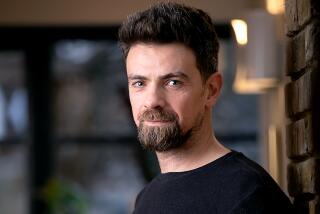“The Sky Below: A Novel” by Stacey D’Erasmo
The Sky Below
A Novel
Stacey D’Erasmo
Houghton Mifflin Harcourt: 288 pp., $24
Gabriel, the chimerical narrator of “The Sky Below,” Stacey D’Erasmo’s episodic novel of mayhem and myth, was not the sort of boy his “sad brown bear of a father” could bond with. Entranced by the strange and terrible shape-shifting tales his mother reads to him -- Ovid’s “Metamorphoses,” of all things -- Gabriel is a dreamy 8-year-old when his uncommunicative father takes off, leaving his family destitute. Gabriel, his sister and their mother are forced to give up their Massachusetts home, a funny little fairy-tale cottage that Gabriel believes is enchanted. They move to Florida, where his playful mother confines her long, princessy red hair in a no-nonsense braid and transforms herself into a ferociously efficient motel manager. Gabriel, a fledgling mystic with an outlaw streak, is inconsolable.
Epically homesick, he becomes, he explains, “some sort of reverse rebel: I didn’t run away from home, I ran away to other people’s homes and stood around.” He emerges from the metamorphosis of adolescence tall and roguish, evolving from imp to thief, drug dealer and men’s-room hustler. Gabriel hoards his stash in boxes beneath his bed and carries the weight of a deep, unreachable loneliness.
Beginning with her first novel, “Tea” (2000), in which a young woman fascinated by ancient Rome turns to the theater to try to understand her mother’s suicide, D’Erasmo has channeled the archetypal emotions of classic tragedy into fiction of sublime precision and inventiveness. In “A Seahorse Year” (2004), winner of the Lambda Literary Award, a missing schizophrenic 16-year-old is the catalyst for a complex and insightful tale about nature and nurture, homosexuality and parenthood. In her third book, she imagines a son’s quest for his father. An acutely visual writer, D’Erasmo is also keenly aware of the repercussions of our habit of storytelling, the divide between the stories we tell ourselves and the stories others tell about us as well as the contradictory tales we tell about the divine.
As significant as D’Erasmo’s intellectual and aesthetic preoccupations are, they can be intrusive early on. Gabriel’s accounts of his younger self are too clever by half -- what with their checklist approach to tropes and themes. The descriptions of his interlude as an art student in Arizona obsessively at work on fetishistic, Joseph Cornell-like boxes are braggadocio with a thesis: “I made a Tereus box out of feathers and bones that I’d found along the trails outside, plus some arrows I pulled out of a souvenir Indian maiden’s tiny suede quiver.” Why does he identify with Tereus? Has he done anything as vile as Ovid’s rapist and mutilator? Does he feel guilt on that scale? Will the gods turn this tormented, elusive young man with an angel’s name into a bird as they did Tereus and the sisters he so brutally betrayed? Gabriel does have striking encounters with birds, but he is also associated with another totem animal, the bull. After surviving a shocking visitation by a stampeding ghost herd, he moves to New York, where every day he passes Wall Street’s “huge bronze bull” on his way to work.
It is in the New York sections that D’Erasmo, who is now teaching at Columbia University, succeeds in blending the cerebral with the spellbinding. Everything suddenly snaps into place, and the novel gains intensity and velocity. We have liftoff, and what a flight it is: topsy-turvy, so that we look down at the sky and plunge into the underworld, because, as every myth-lover knows, the hero must confront the dead in order to be fully alive.
Gabriel, arch and wistful, his homosexuality overt while his criminality is well concealed, keeps building boxes and filling them with “the stuff of transformation,” creating shrines in an attempt to make a whole out of fragments. As he longs for another transforming visit from the gods, he becomes, seemingly out of the blue, the obituary writer for a nearly moribund newspaper with offices just blocks away from ground zero.
In the “city of the dead,” everything is poisoned. Towers and lives have turned to ash. Gabriel’s dwindling paper is destined to leave the tangible world and become purely light online. A house in Brooklyn that Gabriel covets mutates from a charming sanctuary to a desiccated shell. He strikes up a clandestine relationship with Fleur Girard -- the pseudonymous author of the bestselling “Stolen” series, sexy thrillers featuring high-heeled vixen-goddesses -- only to see Fleur, ensconced on a golden divan and swathed in cashmere and fury, suffer debilitation. Gabriel observes, “Her face looked like the joined masks of comedy and tragedy.”
Gabriel is also attacked from within. Through his pain, he feels as though he’s turning into a bird, and he can’t stop looking at the sky. Finally, he escapes haunted New York and lands in Mexico. There he finds redemption in the ruins of a 16th century convent, home to a motley band of outsiders (including a woman called Malcolm X) gathered around young Julia, an indigo child, he’s told, “who’s been given special abilities and sent to Earth to change the world and lead us into the future.” In scenes of eerie beauty, sly wit and bewitching power, Gabriel descends to the underworld to seek his wings.
Experiencing a rare moment of artistic confidence, Gabriel declares, “I had just invented this great thing, pagan realism.” This, of course, is pure hubris, swiftly punished. But it is also a key to D’Erasmo’s mythic vision of life’s dualities and perpetual flux.
In her conceptually brilliant, imaginative, brimming and suspenseful novel, her evocations of place are ravishing; her characters are at once richly human and magical and their confounding predicaments are both commonplace and cosmic. Erotic and mystical, intricately made and deeply felt, “The Sky Below” is a vivid tale of profound dimension and resonance.
Seaman is an associate editor for Booklist and book critic for Chicago Public Radio. Her author interviews are collected in “Writers on the Air,” and at www.openbooksradio.org.
More to Read
The biggest entertainment stories
Get our big stories about Hollywood, film, television, music, arts, culture and more right in your inbox as soon as they publish.
You may occasionally receive promotional content from the Los Angeles Times.






